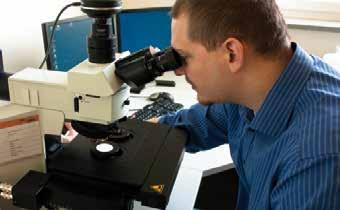
3 minute read
OELCHECK identifies solid impurities in lubricating greases
With almost 10,000 tests of used lubricating grease specimens this year, OELCHECK is the world-leading service laboratory for waste grease analyses. Affordable analysis sets are available for the routine inspection of lubricating greases. Almost all everyday problems can be covered off with the testing methods included in the kit.

In addition, further special tests are available, for example for experimental observations or questions in connection with stock disturbances. One of these is the determination of the amount and type of particles and solid impurities which are found in the lubricating greases used. Mostly, such particles which originate from slowly running rolling bearings or swing bearings are visible in the grease specimens to the naked eye (>70 µm). Alongside soft particles from the grease ageing and solid impurities (dust) from the surroundings, such greases often contain metallic wear debris from the components of the bearing such as bearing cages, tracks or rolling elements. The shape, hardness, amount and size of the solid impurities influence the service life of the rolling bearings. Therefore, increasingly higher demands for improved cleanliness are placed not only on the oils but also the lubricating greases.
For the determination of stubborn component parts there is a method defined in DIN 51813 – however only for fresh greases – of how solid materials of over 25 µm in piece size can be quantitatively detected through high pressure filtration using a filter with a 0.025 mm pore size from a large fresh grease amount of 0.5 kg. This method is not suitable for waste grease analyses. Processing the specimens in accordance with this standard is only used in the OELCHECK laboratory for the tests not requiring much effort.
For the waste grease analysis, the identification of wear or impurity elements and additives belongs to the standard of an analysis set. For this 27 elements such as iron, chromium, silicon, sodium, zinc and phosphorus are identified in accordance with the Rotrode method. The element contents are given in mg/kg. Unfortunately, very large particles can only be viewed with the atom emission spectroscopy up to a size of approximately 5 µm through the LDE arc, with which the individual component parts are stimulated.
If there are visible particles (>70 µm) in a waste grease specimen, the identification of the elements is not always precise. Here, conclusions can be drawn on the wear condition of the lubricated elements with the „Identification of the content of stubborn materials“. However, this method only functions for soap thickened lubricating greases without solid lubricants. Three grams of lubricating grease are required.
In order to be able to filter out the impurities from the grease, the solid grease must be dissolved. This occurs with intensive stirring after adding a solvent mixture of methylene chloride, ethanol, heptane and acetic acid under temperature influence. By destroying the soap structure, the grease becomes liquid and can be filtered. The solid particles are separated during filtration with a special 10 µm Teflon membrane. After washing out and drying, the membrane can be used to calculate the percentage of solid materials using a differential weighing. In the laboratory report, the content of solid impurities appears with a particle size of over 10 µm as a mass in mg/kg. An image of the membrane from which the shape of the particles follows is supplied. OELCHECK does not only identify the content of solid impurities in the grease specimen but also carries out some further tests. Only using this method can even more precise conclusions be drawn on any wear processes.
The particles caught in the Teflon filter are recorded with the help of an OLYMPUS special microscope. The large particles are recorded individually and microscopically scanned in incidental light mode. All particles appearing darker in the grey scale of the membrane are photographed with a high-resolution CCD camera. Through differing reflection using polarised light, a distinction can be made between metallic and non-metallic impurities. This informa- tion as well as the shape and colour of the particles provides the diagnostic engineer with important information on the type of the materials present (cage, rolling elements, inner or outer ring) and a possible wear process (outbreaks due to fatigue, wear due to hard impurities and corrosion).
If particles remain on the Teflon membrane and the amount of remaining grease used is still sufficient, a further analysis with the REM-EDX method presents itself. REM stands for „scanning electron microscopy“ and EDX for „energy dispersive X-ray spectroscopy“. In order to record the particles with this, the dissolved grease must however be filtered with a gold filter membrane. The membrane is then observed and evaluated under a vacuum with the scanning electron microscope. In the process, an electron beam goes in a certain pattern over the enlarged depicted object. The interactions of the electrons with the wear particles on the filter are used to create an image. The electron beam has a relatively small diameter, hits the particles separately and provides images with a very high resolution.
The energy dispersive X-ray analysis spectroscopy connected to the REM serves to determine the elemental composition of the material. If an electron from the electron beam in an atom of the specimen hits a electron close to the nucleus from its position, this is immediately filled in by a high-energy electron from a higher electron orbit. The energy difference is established in the form of an X-ray quantum. The X-rays that result are each characteristic for a certain element. The composition of the particles is recognised using special detectors. Wear processes can be located even more precisely through the metal alloys determined in this way such as FeCr, CuPbSn.


